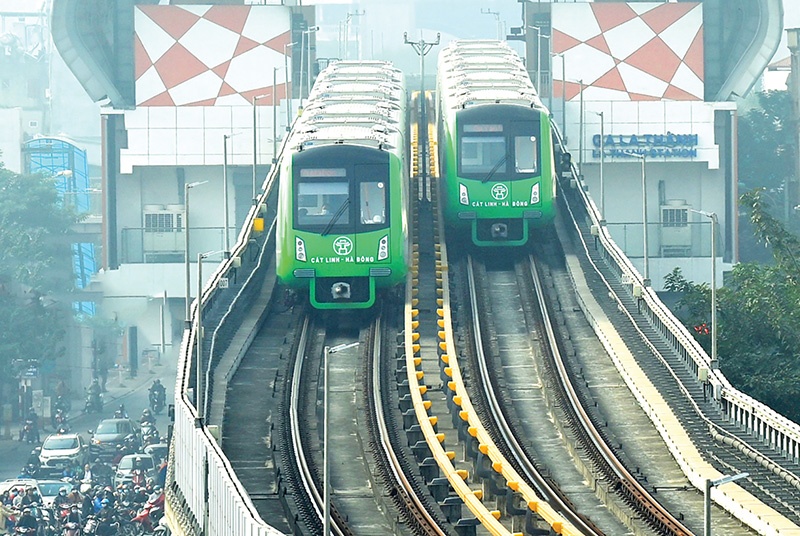Metro era finally begins for Vietnam
 |
| The Ha Dong-Cat Linh line in Hanoi is set to be the first of several to be developed this decade, Photo: Le Toan |
The long-awaited Cat Linh-Ha Dong metro line in Hanoi was given a test run for the final time on November 4 before being put into official operations two days later, after a decade of development.
The commercial kick-off of the metro line marks an important milestone for public transport, especially in the capital which struggles with traffic pressures at peak times. Currently, public passenger transport in Hanoi and Ho Chi Minh City consists of only buses, while rapid urbanisation over the years has resulted in serious traffic jams. In 2020, the urban population in Vietnam stood at approximately 36.35 million people. The six largest urban hubs include Hanoi, Haiphong, Danang, Bien Hoa, Ho Chi Minh City, and Can Tho.
Vietnam has invested in many expressways, national highways, beltways in urban areas, and large airports, as well as bus rapid transit systems being developed. However, traffic issues do not seem to be heading in the right direction.
Together with the Cat Linh-Ha Dong line, five others are being developed in both Hanoi and Ho Chi Minh City. The development of the first line brings costly lessons for Hanoi and Ho Chi Minh City in developing future ventures to ensure their success and to prevent possible delays. In the government’s recent report sent to the National Assembly on the situation, most developing metro lines in the two cities are lagging far behind schedules, and total investments have increased.
Kicking off in 2011, the Cat Linh-Ha Dong line was beset with delays. The line is 13km long and had initial investment capital of about $553 million which was increased to $868 million in 2017.
Deputy Minister of Transport Nguyen Ngoc Dong admitted there are several valuable lessons the country should learn from the metro line issues. “The country has yet to have a set of standards for metro lines in general, and preparation was not sufficient. It failed to anticipate the barriers, thus causing a lot of adjustments and a time-consuming process.”
Dong added that Vietnam may need to separate site clearance into a specific sub-project to fast-track implementation. It took three years for the Cat Linh-Ha Dong line to be built and have equipment installed, but this work began when site clearance was not complete, thus lengthening the project timeline by years.
A further problem was a lack of consistency in regulations in engineering, procurement, and construction (EPC) contracts as ruled by the FIDIC, a global standards organisation that has members in over 100 countries.
“In the EPC contract, general contractors take total responsibility for the design and construction of the infrastructure or other facility. Meanwhile, in Vietnam, the investor approved the design and capital estimation. We should study further to have detailed regulations of the management of EPC contracts,” Dong noted.
Lack of experience was also a major cause, he added. “For this metro line, we selected a local consulting contractor that was not experienced. For future ventures, the selection will be stricter, with the possibility of hiring international contractors,” he elaborated.
According to the deputy minister, the solution to site clearance is expected to come as the National Assembly is considering the separation at its ongoing session.
The Cat Linh-Ha Dong line is one of eight metro lines Hanoi has planned. Others are under construction, including the 12.5km Nhon-Hanoi Railway Station line, expected in late 2022, while a line connecting West Lake to Hoa Lac is also being considered.
The government initially assigned Ho Chi Minh City People’s Committee to develop two metro lines – Ben Thanh-Suoi Tien and the Ban Thanh-Tham Luong. In 2013, the prime minister approved adjustments to the city’s transport development planning, with the southern economic hub now set to eventually boast eight metro lines.
What the stars mean:
★ Poor ★ ★ Promising ★★★ Good ★★★★ Very good ★★★★★ Exceptional
Related Contents
Latest News
More News
- Global partnerships key to Vietnam’s IFC development (December 26, 2025 | 16:18)
- Vingroup pulls out of bid to invest in North-South high-speed railway (December 26, 2025 | 11:42)
- Strengthening supply chains through trade promotions and customs reform (December 24, 2025 | 14:00)
- PM orders investment model for North–South high-speed rail (December 22, 2025 | 17:43)
- LS Eco Energy to invest in Vietnam rare earth sector (December 22, 2025 | 17:31)
- Government moves to establish International Financial Centre (December 21, 2025 | 21:00)
- Vietnam's IFC to target global investment flows (December 21, 2025 | 18:00)
- Two national hospitals expand capacity with new facilities (December 20, 2025 | 09:00)
- Ha Tinh breaks ground on major Vingroup industrial and energy projects (December 19, 2025 | 18:24)
- EVN launches major power infrastructure projects nationwide (December 19, 2025 | 18:17)

 Tag:
Tag:





















 Mobile Version
Mobile Version